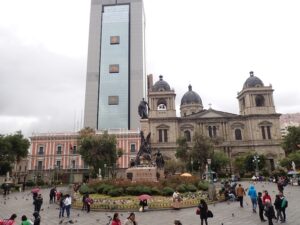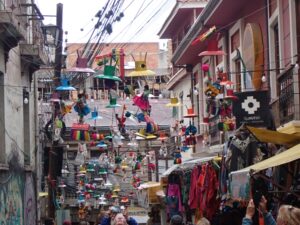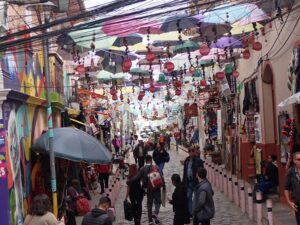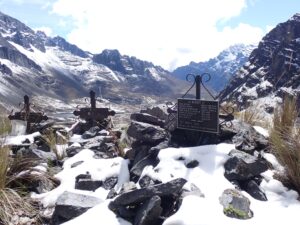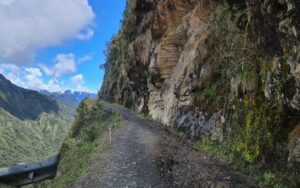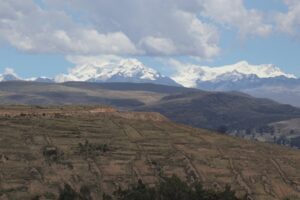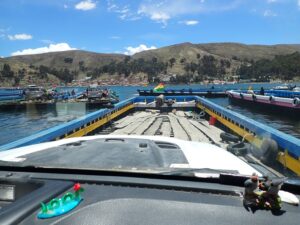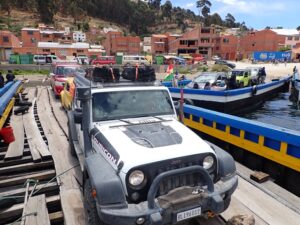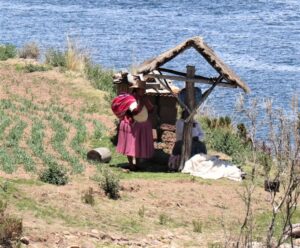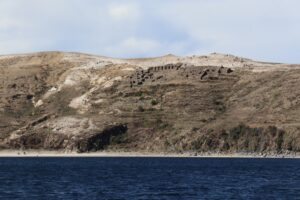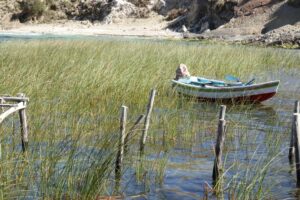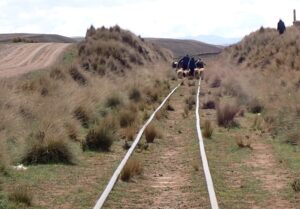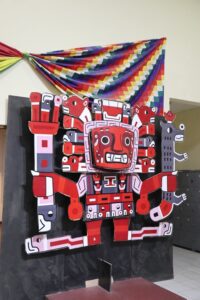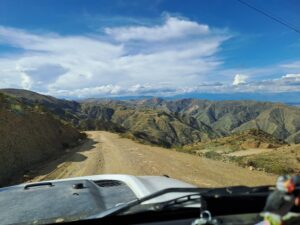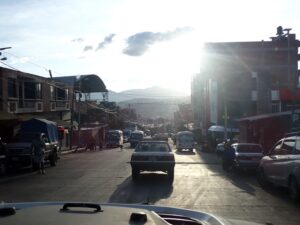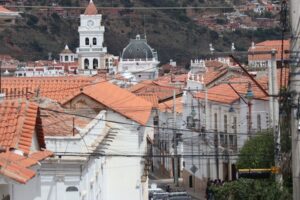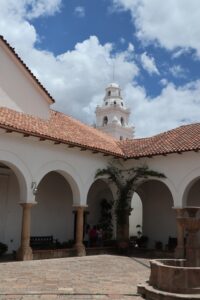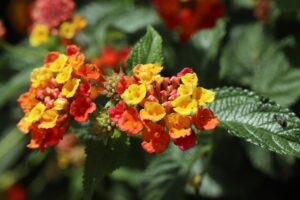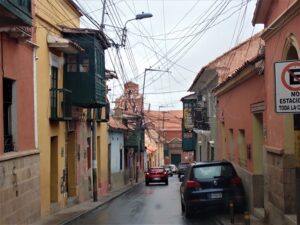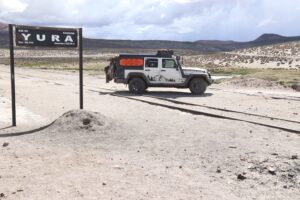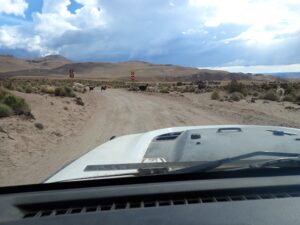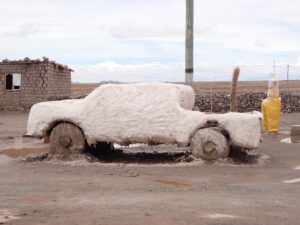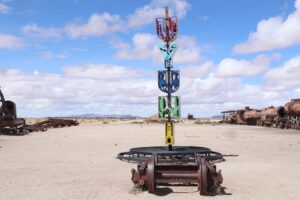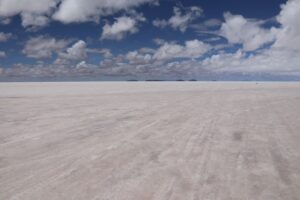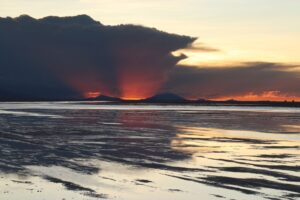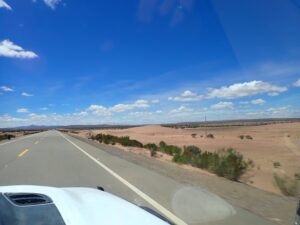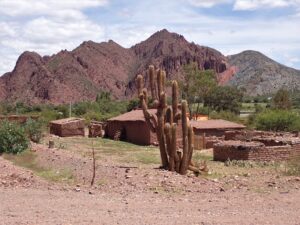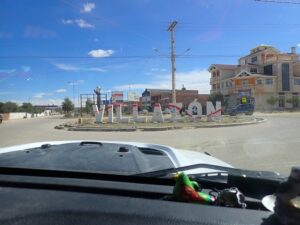>Translated with www.DeepL.com/Translator
(>Pictures at the bottom!)
….in waiting loop!
The entry into Bolivia, coming from Chile, was extreme. No, not the landscape, which is very beautiful and varied, but the whole thing around it and how the people live. For us Europeans, and we count ourselves among them, the everyday chaos is both fascinating and daunting. Upon arrival in “La Paz”, we were already overwhelmed. In the following days, we asked ourselves again and again how anything could still function in such chaos.
We explored the centre of “La Paz” on foot and by cable car, which gave us a very impressive view from above and showed us the hustle and bustle of the streets below. Our guide was a German who had stayed here a long time ago and explained the city and the country with its customs very impressively. What he told us is probably not in every travel guide; very critical, humorous and also encouraging. But it still remained chaotic.
As a change from the hustle and bustle of the city, I (Tom) and other cycling enthusiasts from our group experienced a bike tour outside the big city on the notorious “Rute de la Muerte”. For a long time, this road was the only connection from “La Paz” to the northeastern lowlands and was known all over the world as the road of death. Thanks to a new road, this death road is now open to leisure traffic and is very popular with cyclists. Many travel agencies advertise the adventurous tour, where many biker groups roar down a whole 3,500 metres of altitude on their freeride bikes. It was an adventure, and the many crosses on the roadside still bear witness to the countless dramas and deaths. With the many narrow passages and slopes, it was “forbidden to fall” even on a bike; to avoid more crosses! After the many metres in altitude, we were driven back to “La Paz” together with the bikes in a minibus. But even the return journey on the new roads was hardly better than the ride on the road of death; hair-raising overtaking manoeuvres and accidents were witness to the insane car and truck drivers in this country.
In the meantime, it was also clear that we would not be able to continue our journey northwards towards Peru as planned. The ongoing unrest was spreading rather than calming down. For the time being, our travel organisation planned a waiting loop through Bolivia and northern Argentina, so that if the situation calmed down in Peru, we could turn around immediately and head north again.
Of course, Lake Titicaca could not be missing from this waiting loop and a small corner of this lake belongs to Bolivian territory. So we – 19 campers – drove through “La Paz/El Alto” again on different routes and all experienced about the same: Chaos on the streets with the countless markets. When there was not enough space at the roadside for the market stalls, one lane of the road was unceremoniously converted into a market. The many small and shared taxis were sure to block another lane, plus all the parked cars whose drivers wanted to shop at the market – if you were lucky, one lane remained free for through traffic.
In the evening, everyone reached “Copacabana” on Lake Titicaca and reported on the many impressive experiences during the passage through the capital and the neighbouring suburbs. We, too, had experienced some hair-raising moments, but mostly we were able to get out of the situation very slimly; an advantage of a small and inconspicuous camper.
Due to one of the many national holidays, there was a lot going on in “Copacabana” and there was a lot of excursion traffic on the lake. We also took the opportunity to make a day trip to Sun and Moon Island on the highest and commercially navigable lake. Here – according to our guide – are many excavations and evidence of a time long past. Before the Incas subjugated the area, another advanced civilisation was present here. On the return trip, we were promised a visit to a floating island, which would certainly have been a great alternative due to the discontinuation of floating islands in Peru. It would have been; only the jetty was floating, the restaurant was on a stable rock. But the freshly prepared trout tasted excellent.
For the onward journey, many of us needed the necessary juice for the engines, which is often difficult for foreigners in Bolivia. Fuel is heavily subsidised by the state in Bolivia. For foreigners it is twice as expensive and involves a lot of paperwork. If the petrol station attendant does not want to sell anything to a foreigner for this reason, he simply gives nothing. Basta! At other petrol stations you pay a hefty surcharge, but without a receipt it became cheaper again and the surcharge probably went straight into the petrol station operator’s pocket. If you walked to the petrol station with a canister, you usually got diesel at the local rate and nobody cared whether I was a foreigner or a local taxpayer. Thank God our jeep doesn’t consume too much and so the hauling with the jerrycan was limited to a few moments.
With a full tank, we headed for the spiritual and cultural centre of the Tiwanaku. This culture originated around 4000 years ago and was only colonised by the expansion of the Inca Empire. Actually, it always amazed me that in Europe we mainly talk about the Incas – the other cultures are almost non-existent.
Via “Cochabamba”, the place with the second largest statue of Jesus on the local mountain, we reached “Sucre”, the noble residence of the high society from “Potesí”. We thought we had driven through the centre and wanted to continue the next day, as we were immediately repelled by all the trappings of this city. The guide then convinced me that I should follow him into the city. In the end, this was not a bad decision: the centre was more than worth a visit. The historical part has been saved from decay or demolition until today and is still a testimony to the former wealth from silver mining in the neighbouring “Potesí”. By the way, for a long time “Sucre” was the political centre and capital of Bolivia until some president moved the political business to “La Paz”. The highest court, however, remained in “Sucre”, but – according to our guide – this court has more of a token function and with a little money some things can be influenced; which can often be the case in poor countries, and Bolivia is one of the poorest countries in South America.
When passing through “Potosí”, this time we chose to drive through the main square, so we could decide differently. Besides the beautiful square near the town hall and the cathedral, the oldest mint in South America, our hunger for more sights was soon satisfied. The chaos was once again typical for us and the rainy weather probably intensified the experience even more. We saw nothing of the “Cerro Rico” anyway due to the low-hanging clouds and as a foreigner you are not allowed to dig for silver on the flanks of this former volcano. The fact that it was precisely because of this mountain and its silver deposits that the Spanish crown held on to Bolivia for a long time and that the liberation struggle cost a lot of blood still bears witness today to the former greed for gold and silver.
After the vibrant city, we spent a quiet night on a country estate. This once belonged to an important family who earned their wealth from silver at the “Cerro Rico”, and was taken over by a rich Frenchman almost 100 years ago and converted into a hotel-museum. A museum where all hotel guests can walk around freely in most of the rooms and even touch ancient books; at home, everything would already be packed behind glass and a protective atmosphere; but, different countries, different customs.
Chantal and I said goodbye to the group and climbed on adventurous paths through the “Cordillera de Chichas” towards the railway line, which still climbs over 4’600 metres and brings many minerals to the Pacific coast. Through many valleys we finally reached the highest point later in the afternoon and could not quite keep to our schedule. However, the altitude and thick clouds drove us to find a lower area and place to spend the night. Besides the altitude and the direct consequences of the thin air, I was more concerned about the increasingly frequent lightning. At a disused railway station – the railway still passes by – we found protective walls and a safe place for the coming night.
The rain was quite extensive and the next day we experienced rainy season in the Bolivian highlands, where even simple roads (tracks) are suddenly skidding courses and our jeep was soon covered from bottom to top in a brown-black dress. We also turned back prematurely at the edge of the “Salar de Uyuni” (Colchani): The mud and mire was getting deeper and deeper and we definitely did not feel like rescuing ourselves with our Maxtrax (special sand plates) or even a winch in this rainy weather.
To visit or drive through the “Salar de Uyuni”, the second largest salt lake in the world, we booked a tour in an off-road vehicle with other group members. Travelling in our own car, i.e. us with our jeep, would be equivalent to an intensive salt bath, so we preferred to sit in the off-road vehicle of a local provider. It goes without saying that the organisation of such a tour for individual tourists can often lead to certain discrepancies. So in the end, two different tour operators were commissioned, who could not have been more different. I (Tom) was travelling with two other members of the “Panamericana” group and made a point of “experiencing” the salt lake, i.e. covering many kilometres on it. The other group, which included Chantal, covered much less kilometres, but they were given a lot of information about the salt lake and its use and, last but not least, they enjoyed a glass of wine while watching the sunset in the south-eastern part, which is under water during the rainy season. While this group enjoyed the setting sun and sipped wine, our guide chased the time with his off-road vehicle and thundered over the salt surface, but the sun disappeared behind the clouds without us. Well, sometimes things go wrong here too 😉
After the semi-private excursion to the salt lake, we continued our journey southwards again. The joint joining of our waiting loop was planned in Salta/Northern Argentina. While the rest of the group drove through the wine region “Tarija” towards the Argentinean border, we – the Salt Lake travellers – headed for the crossing of “Villazón”/”La Quiaca (Arg.)”.
After the wide plains and countless “Cordilleras”, we finally reached the double city, where the national border runs right through the middle. Almost unknowingly, we headed for the border post, were somewhat surprised by the hustle and bustle of the traders and many people on the Bolivian side; all chaotic again, but still always worth a look. At the border we were immediately turned back; we were not allowed to queue or park here until we had completed our papers. On an unguarded car park, we put our jeep next to the vehicles of the already present group members and made our way to the border station on foot.
Where others in our group needed almost 5 hours, we were through in less than an hour and had all the stamps and paperwork for leaving the country. But no sooner did we make our way back to the jeep than we were informed that a camper had been broken into and many electronic devices had been stolen. Shock! What about our car? And something else: How do we get our paper, which is necessary for crossing with a number and order?
What we didn’t know again was that next to our free parking space was the official and guarded car park, where you also get the corresponding number for crossing the border and would have made everything a bit easier. For the last “Bolivianos” we got hold of the corresponding paper and hoped that it would still be possible to cross into Argentina on this day. Our number was correspondingly high and already foreboded bad things to come. Suddenly, everyone in our group who was still there became a little nervous and was told that we could go to the border post immediately. This message struck a chord with everyone – Bolivians, Argentines and tourists – and there was already the first crowd in front of the border post. An official lined up the vehicles on the road so that a passageway remained free. Suddenly the official disappeared (probably after work) and the order in the queue was over. Everyone thought they had more rights than the others and the closer we got to the border post, the more ruthlessly the cars were pushed into possible gaps. The verbal attacks were uncharacteristic for the otherwise very calm South Americans and fisticuffs made the rounds. While a smaller person from our group got out of her vehicle to negotiate the order, she got into a somewhat uncomfortable position, which in turn prompted Chantal to intervene and, with her size, did cause some respect among the smaller South Americans. But during this action, others shamelessly took advantage of the situation to threaten the driver of the vehicle in question and immediately steal everything they could from the vehicle. I think this is called robbery!
The heart was still beating strongly and in front of me (Tom) a car driver tried to squeeze into the narrow gap. Had he not noticed my steel bumper yet? Quick-witted, I asked him for his number for the border post and he had 77 and we had 78. For us, it was immediately logical that he was allowed to line up in front of us, and so we had immediately prevented a small war.
And the border control? For us tourists, it was more of a formality. Our vehicles were inspected curiously, while the Argentines usually had to unload their entire vehicle for inspection. Drugs of all kinds were searched for, while we were almost kindly asked to continue our journey.
Shortly before midnight, we – the entire small group from the Salt Lake – finally reached the Argentinian side and were glad that those ahead had already found an appropriate place for the night. Dead tired, we soon lay down to rest and many thoughts rolled around in our heads and questions remained unanswered about what it would be like to run into some roadblock in Peru and not have any law enforcement officers standing by anywhere.
We are still in a holding pattern and are waiting for calmer times in Peru, but the experience made our hopes fade even more; the news from Peru is anything but encouraging.
Wait and see – time will tell. :-/
Chantal & Tom/14 February 2023
>Translated with www.DeepL.com/Translator










